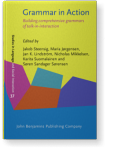Chapter 6
Responses to specifying WH-questions, and their place in a
comprehensive grammar of interactional Danish
This chapter examines how interactional analyses of
response formats to specifying, information-seeking WH-questions in
Danish may inform a comprehensive grammar of Danish
talk-in-interaction. Based on analyses in Jørgensen’s work (2024), phrasal responses are
shown to index sequential embeddedness and treat questions as part
of an ongoing trajectory, whereas clausal responses are shown to
treat questions as initiating new sequences and trajectories. This
chapter analyzes how these descriptions could inform an
interactional, comprehensive grammar. I find that it would be useful
to include some traditional, grammatical concepts to account for the
formats and their differences. However, adopting a more locally
specific and positionally sensitive perspective is even more useful.
Furthermore, this perspective can be used a tool for discovering
levels of organization at finer levels of granularity.
Article outline
- 1.Introduction
- 2.Data and method
- 3.Responses to specifying WH-Questions in Danish
- 3.1Phrasal responses that index sequential embeddedness
- 3.2Clausal responses that index independence
- 4.How do the analyses inform a comprehensive grammar of
Danish?
- 4.1The impact of the analyses on the Building Blocks section of the grammar of Danish
- 4.1.1Defining phrases and clauses: Abstract models
- 4.1.2Defining phrases and clauses as they occur in
interaction
- 4.1.3Inter- and intra-unit syntax: Product syntax
models
- 4.1.4Inter- and intra-unit syntax: Social action format
models
- 4.2How do the analyses inform the Social Actions section of the
grammar?
- 4.2.1Social Actions: Questions in general and WH-questions in
particular
- 4.2.2Social actions: Responses to WH-questions
- 5.Discussion
- 6.Conclusion
-
Acknowledgements
-
Notes
-
References
This content is being prepared for publication; it may be subject to changes.
